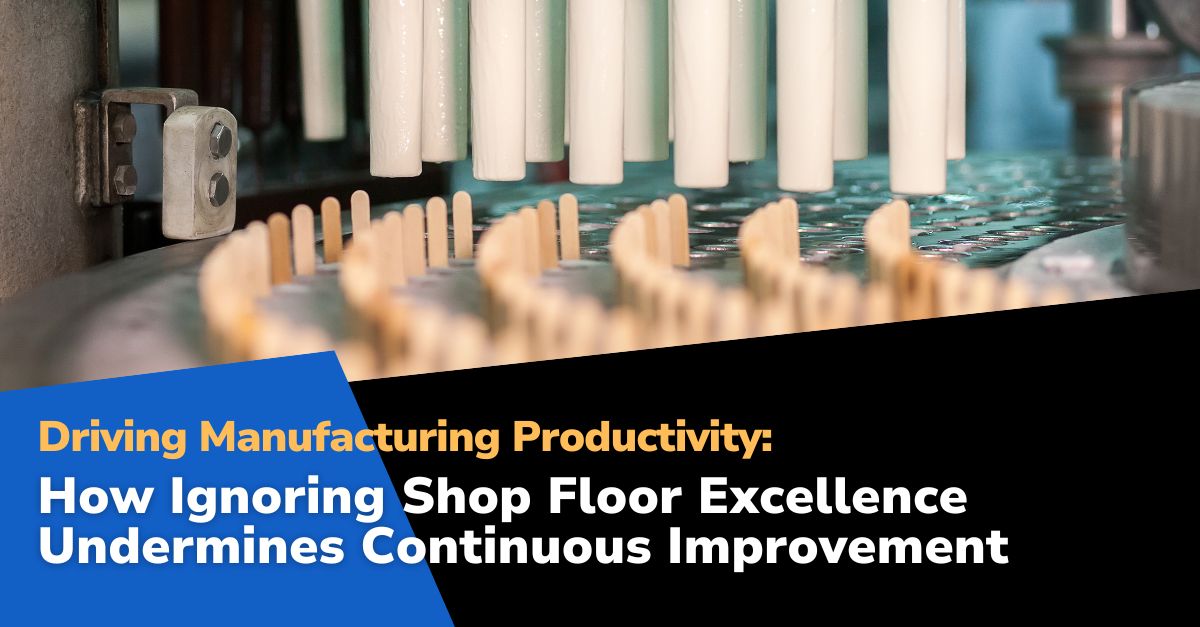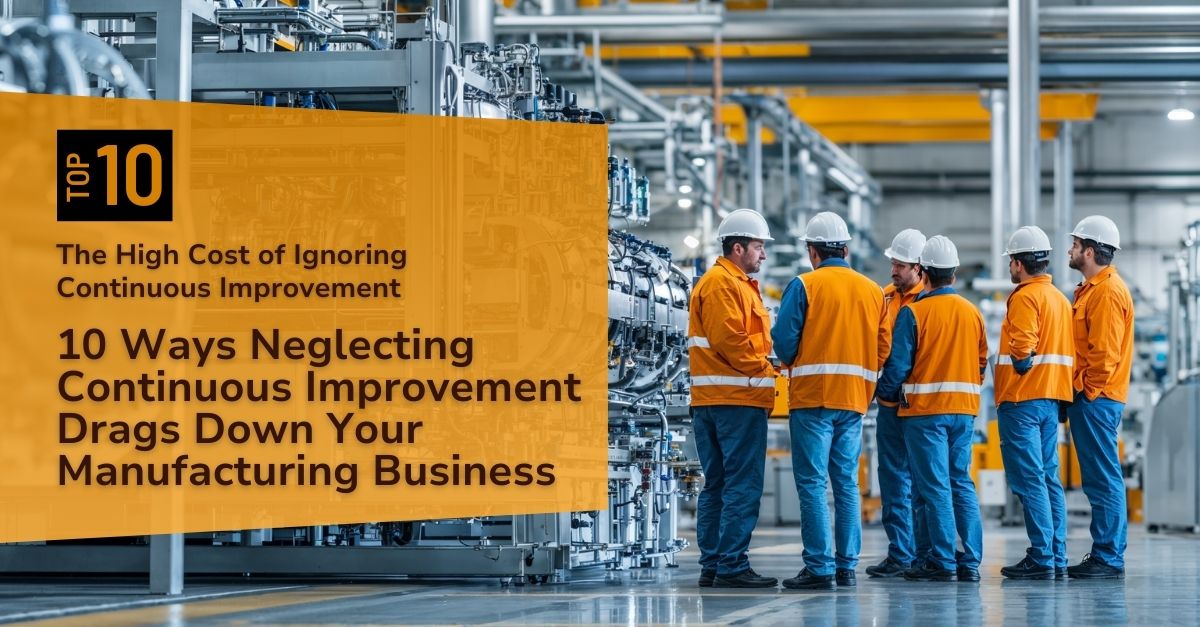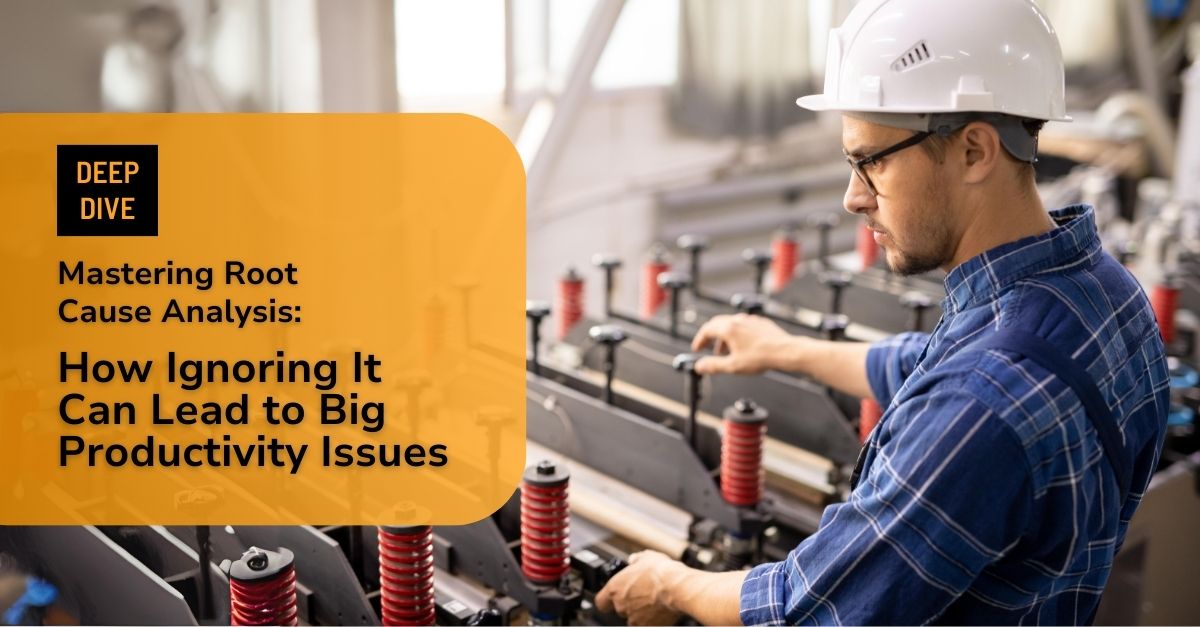
Continuous improvement has become a non-negotiable in modern manufacturing, not just to stay competitive, but to survive.
Yet many initiatives fail to gain traction because they overlook one crucial factor: execution on the shop floor. That’s where Shop Floor Excellence (SFE) comes in.
SFE isn’t just about enforcing standards or cutting waste. It’s about creating the environment, routines, and leadership behaviors that make continuous improvement stick. Without it, even well-intentioned improvement plans can become temporary fixes, isolated projects, or worse, abandoned altogether.
In this eighth installment of our series, we explore the top 10 risks manufacturers face when they neglect SFE in their improvement efforts. Each of these challenges chips away at performance, engagement, and resilience, but with the right structure in place, each one can also become a lever for transformation.
1Stagnation in Innovation and Process Improvement:
Without mechanisms for capturing and acting on ideas from the shop floor, improvement becomes sporadic. When frontline teams aren’t engaged, innovation slows and companies revert to outdated routines, even if they’re inefficient.
Solution: Build structured improvement programs that tap into employee insight. Use suggestion systems, idea boards, and pilot programs to test improvements in real conditions. Recognize and reward participation to keep momentum alive.
2Decreased Operational Efficiency:
When daily operations lack structure, inefficiencies become invisible. Workarounds pile up, productivity stalls, and teams operate in reactive mode. Even basic time and motion issues go unnoticed without routine floor-level scrutiny.
Solution: Use SFE principles like standard work, visible performance tracking, and tiered accountability to expose and address inefficiencies. Conduct regular line audits and empower teams to make incremental changes on the spot.
3Poor Quality Control:
Quality issues often stem not from a lack of care, but from inconsistent processes, unclear expectations, or delayed feedback loops. Without a system for identifying and correcting root causes at the floor level, defects become normalized.
Solution: Strengthen frontline ownership of quality by linking real-time data to visual controls, tiered huddles, and escalation procedures. Train operators to use tools like 5 Whys, FMEA, and FTA to solve recurring issues proactively.
4Reduced Employee Engagement and Skill Development:
When improvement efforts happen above or outside of the shop floor, employees disengage. They may feel like executors, not contributors. Over time, this leads to reduced motivation, a widening skills gap, and even turnover.
Solution: Create intentional pathways for development aligned with operational goals. Use cross-training, mentoring, and skills matrices to build capability while keeping employees engaged in meaningful improvement work.
5Ineffective Resource Utilization:
From bottlenecks to machine underutilization, poor visibility leads to poor decisions. Without SFE structures, it’s difficult to identify where labor, materials, or equipment are being misapplied, and even harder to correct course quickly.
Solution: Combine daily production reviews with digital tools like the POWERS Digital Production System (DPS) to visualize resource performance in real time. Assign ownership to team leads and encourage continuous optimization.
6Inadequate Response to Market Changes:
When shop floor operations lack flexibility, adapting to shifts in demand or product requirements becomes slow and costly. This rigidity can prevent companies from taking on new business or responding to customer needs in time.
Solution: Implement agile operational principles like short production runs, quick changeovers, and pull-based scheduling. Use real-time data to drive faster decision-making and reduce the lag between planning and execution.
7Lower Customer Satisfaction:
Behind most customer complaints are gaps in execution, late shipments, inconsistent quality, poor communication. Without SFE, the link between customer experience and shop floor performance gets lost.
Solution: Connect customer feedback directly to frontline teams. Use Voice of the Customer (VoC) insights in shift meetings and problem-solving sessions. Make customer-centric KPIs visible and actionable at every level.
8Safety Concerns:
Improvement efforts often prioritize efficiency or quality, but when safety isn’t integrated into daily operations, it becomes vulnerable. Without consistent oversight, even minor lapses can lead to major incidents.
Solution: Treat safety as a production metric. Integrate safety checks into tiered huddles, include near-miss reporting in daily reviews, and involve employees in developing and auditing safe work practices.
9Wasted Time and Effort:
Without clear goals or follow-up, improvement activities can become busywork. Employees spend time on projects that lack ownership, and leaders struggle to see a return on time invested.
Solution: Use SFE to align improvement work with business priorities. Set SMART goals for initiatives, assign clear roles, and close the loop with outcome reviews. Measure not just completion, but impact.
10Inability to Attract and Retain Talent:
A stagnant, chaotic, or underdeveloped shop floor is a red flag for job seekers. Skilled workers want to join organizations that invest in people, process, and progress, not ones stuck in survival mode.
Solution: Position your plant as a place for growth. Use improvement efforts to highlight career development, team recognition, and frontline ownership. Create a culture where employees see their ideas matter, and their future grow.
How POWERS Helps You Make Continuous Improvement Stick
At POWERS, we don’t just talk about continuous improvement, we help you operationalize it.
For many manufacturers, improvement initiatives struggle not because they lack vision, but because they lack structure at the point of execution. That’s where Shop Floor Excellence (SFE) makes the difference, and where POWERS steps in.
We work directly with your leadership, frontline supervisors, and operators to build the behaviors, systems, and routines that turn improvement ideas into sustainable outcomes. Our approach is practical, people-focused, and driven by results you can see in your KPIs and your culture.
At the core of this transformation is our Digital Production System (DPS), a purpose-built platform that brings visibility, structure, and discipline to daily operations.
Here’s how DPS and SFE work together to support lasting improvement:
- ✅ Real-Time Visibility
DPS captures key performance metrics at the frontline, giving teams live insight into performance gaps, progress trends, and recurring issues. - ✅ Tiered Accountability
From operators to plant leaders, DPS supports structured tier meetings that drive ownership, reinforce priorities, and ensure issues are escalated and addressed quickly. - ✅ Improvement Execution, Not Just Ideation
DPS tracks improvement actions in real time, not in spreadsheets or binders. Every idea, countermeasure, or coaching moment is documented, owned, and followed through. - ✅ Sustainable Results, Not Short-Term Gains
With SFE as the foundation and DPS as the system, continuous improvement becomes part of the daily work, not a separate project that fades after the consultant leaves.
When combined with our hands-on approach to implementation, the DPS platform becomes more than software, it becomes a disciplined operating model for high-performance execution.
If your continuous improvement efforts are falling short of expectations, the missing link may be on the shop floor, where systems, habits, and leadership need to align.
Contact us at +1 678-971-4711 or info@thepowerscompany.com for a comprehensive solution that aligns your communication practices with the highest standards of Shop Floor Excellence. Let’s work together to build a more connected and productive future in manufacturing.
Continue Reading from this Mastery Series
- Part 1 - The Perils of Overlooking SFE in Assembly Line Setup
- Part 2 - A Lackluster Approach to Shop Floor Excellence Impacts Workforce Engagement
- Part 3 - The Consequences of Sidestepping Data-Driven Decisions in Shop Floor Excellence
- Part 4 - Without Shop Floor Excellence, Product Quality Can Drop Like a Rock
- Part 5 - A Lack of Commitment to Shop Floor Excellence Can Lead to These 10 Safety Issues
- Part 6 - Shop Floor Excellence Makes Your Operation More Agile, Flexible, and Adaptable to Market Changes
- Part 7 - Bridging the Gap with Effective Communication in Shop Floor Excellence
- Part 8 - How Ignoring Shop Floor Excellence Undermines Continuous Improvement
- Part 9 - Tackling Inefficient Energy and Material Use with Shop Floor Excellence
- Part 10 - Enhancing Customer Focus Through Shop Floor Excellence







